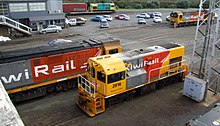Introduction
Originally an order for Philippine National Railways 2500 Class, the six locomotives were purchased as by coincidence NZR needed a heavy shunter for Auckland container port transfer work. At the time two DSC class shunters were linked in tandem to perform this task. The DH class are a light locomotive that is geared to run at 100 km/h (62 mph).
They saw occasional service on the then under-used Auckland suburban passenger network where they performed well, but NZR focused them on their intended purpose, heavy shunting. In the late 1980s, NZR provided a DH locomotive to the Tasman Pulp and Paper mill in Kawerau to trial for sale as a heavy shunter in the mill's rail yards. The mill turned down the offer, instead, they purchased a DA class locomotive to perform shunting duties. In July 1979 DH 905 was trialled at the Te Rapa marshalling yards in Hamilton, but the trial was unsuccessful and the locomotive returned to Auckland later that year. All DH locomotives were allocated to Westfield (Auckland) in 1990. [5]
This page is based on this
Wikipedia article Text is available under the
CC BY-SA 4.0 license; additional terms may apply.
Images, videos and audio are available under their respective licenses.


